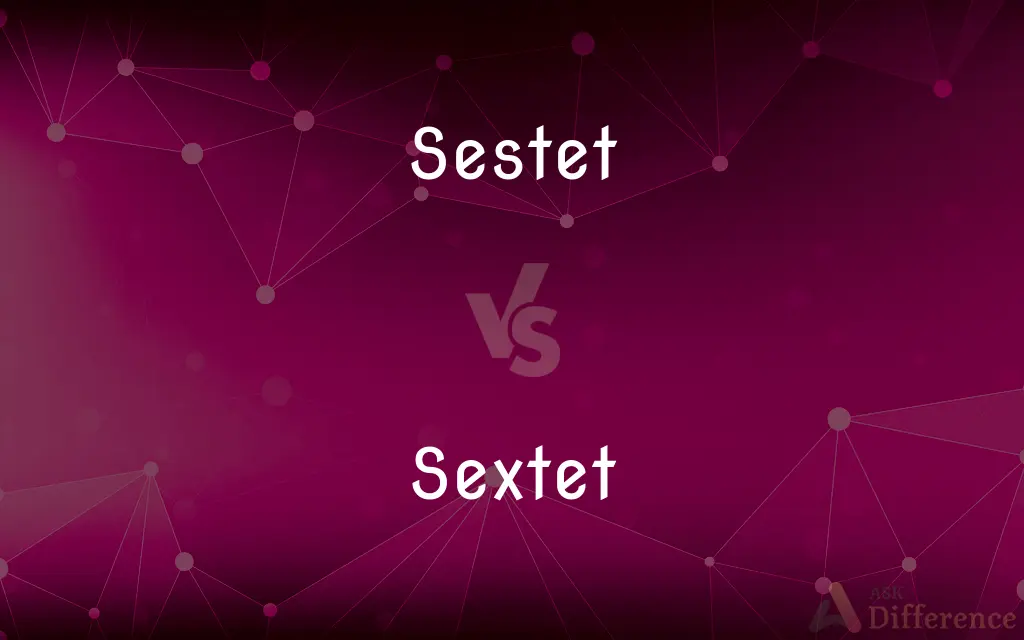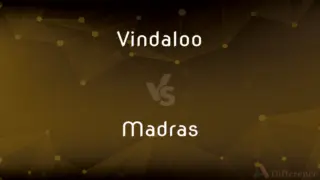Sestet vs. Sextet — What's the Difference?
Edited by Tayyaba Rehman — By Maham Liaqat — Updated on March 10, 2024
A sestet refers to the last six lines of a sonnet or a six-line stanza in poetry, focusing on themes or resolutions, while a sextet denotes a group of six musicians or instruments performing together, highlighting collaborative harmony.

Difference Between Sestet and Sextet
Table of Contents
ADVERTISEMENT
Key Differences
In poetry, a sestet forms the latter part of a sonnet, particularly in the Petrarchan or Italian sonnet, which is divided into an octave and a sestet. The sestet serves to resolve or counter the problem, question, or theme introduced in the preceding octave. A sextet, in the context of music, refers to a group of six performers or the music composed for such an ensemble. It typically involves a combination of instruments or voices that work together to produce a cohesive piece, showcasing the interplay and harmony among the diverse elements of the group.
A sestet is characterized by varied rhyme schemes, such as CDECDE or CDCDCD, and is a pivotal element in the structural and thematic development of the sonnet. Sextets can be found in classical, jazz, and contemporary music genres, each bringing its unique arrangement and synergy.
The sestet in poetry is primarily concerned with the art of words and the conveyance of ideas, emotions, or narratives through a structured form, often culminating in a resolution or philosophical insight. Conversely, a sextet in music emphasizes the collaborative performance of its members, focusing on the blend and balance of sounds, rhythms, and melodies.
Both sestets in poetry and sextets in music showcase the beauty of structure and collaboration, whether through the interplay of words and themes or the harmony of musical elements. They reflect the creativity and skill involved in composing works that resonate with audiences, be it through the rhythm of language or the melodies of instruments.
Comparison Chart
Definition
The last six lines of a sonnet or a six-line stanza.
A group of six musicians or instruments performing together.
ADVERTISEMENT
Focus
Themes, resolutions, and poetic structure.
Musical harmony and collaborative performance.
Key Elements
Meter, rhyme scheme, literary devices.
Instrumentation, arrangement, musical dynamics.
Purpose
To provide resolution or contrast to the preceding lines.
To create cohesive music through ensemble collaboration.
Common in
Petrarchan sonnets and other poetic forms.
Classical, jazz, and contemporary music genres.
Compare with Definitions
Sestet
The concluding six lines of a Petrarchan sonnet.
The sestet in Shakespeare's sonnets often introduces a twist or resolution.
Sextet
A group of six classical musicians.
The sextet performed a piece by Brahms, showcasing their harmonic interplay.
Sestet
A six-line stanza in various poems.
The poem featured several sestets, each with its unique rhyme scheme.
Sextet
Music written for six instruments.
The composer's new sextet was acclaimed for its intricate arrangement.
Sestet
Offering insights or solutions.
The sestet resolved the conflict introduced in the poem's octave.
Sextet
Six singers performing in harmony.
The vocal sextet's rendition of the piece was breathtaking.
Sestet
Rich in metaphor, imagery, and symbolism.
The sestet's imagery brought the poem's theme to a vivid conclusion.
Sextet
Six jazz artists playing together.
The jazz sextet's improvisation highlighted each musician's talent.
Sestet
Exhibiting diverse patterns like CDECDE.
The poet chose a CDCDCD rhyme scheme for the sestet to emphasize the poem's resolution.
Sextet
Present in various musical styles.
The sextet explored a fusion of classical and contemporary genres.
Sestet
A poem or stanza containing six lines.
Sextet
A composition for six voices or six instruments.
Sestet
A sestet is six lines of poetry forming a stanza or complete poem. A sestet is also the name given to the second division of an Italian sonnet (as opposed to an English or Spenserian Sonnet), which must consist of an octave, of eight lines, succeeded by a sestet, of six lines.
Sextet
A sextet (or hexad) is a formation containing exactly six members. The former term is commonly associated with vocal ensembles (e.g.
Sestet
A group of six lines of poetry, especially the last six lines of a Petrarchan sonnet.
Sextet
A group of six singers or six instrumentalists.
Sestet
(music) A piece of music composed for six voices or six instruments; a sextet or sestuor.
Sextet
A group of six.
Sestet
(poetry) The last six lines of a sonnet, forming two stanzas of three lines each.
Sextet
Any group of six people or things.
Sestet
A piece of music composed for six voices or six instruments; a sextet; - called also sestuor.
Sextet
(music) A composition for six voices or instruments.
Sestet
The last six lines of a sonnet.
Sextet
A group of six singers or instrumentalists.
Sestet
The cardinal number that is the sum of five and one
Sextet
See Sestet.
Sestet
Six performers or singers who perform together
Sextet
A musical composition written for six performers
Sestet
A set of six similar things considered as a unit
Sextet
The cardinal number that is the sum of five and one
Sestet
A musical composition written for six performers
Sextet
Six performers or singers who perform together
Sestet
A rhythmic group of six lines of verse
Sextet
A set of six similar things considered as a unit
Sextet
Six people considered as a unit
Common Curiosities
What defines a musical sextet?
A musical sextet consists of six musicians or instruments, performing together in harmony.
How does the function of a sestet differ in poetry?
In poetry, a sestet functions to provide a resolution, counterargument, or thematic shift, particularly in sonnets.
What genres can you find sextets in?
Sextets are common in classical, jazz, and various contemporary music genres, each bringing unique arrangements.
Can a sestet have a fixed rhyme scheme?
While sestets can have varied rhyme schemes, some forms, like the Petrarchan sonnet, may follow specific patterns such as CDECDE.
What challenges do musicians face in a sextet?
In a sextet, musicians must work closely to ensure tight coordination, balance, and blending of their individual parts.
What is a sestet in poetry?
A sestet refers to the last six lines of a sonnet or any six-line stanza, often used to resolve or contrast the themes introduced earlier.
How does a sextet achieve musical harmony?
A sextet achieves harmony through the careful arrangement and interplay of its six members' sounds, balancing melody and rhythm.
What is the significance of a sestet's rhyme scheme?
The rhyme scheme of a sestet can emphasize thematic shifts, resolutions, or contrasts, adding depth to the poem's structure.
Can the structure of a sestet impact a poem's message?
Yes, the structure and content of a sestet can significantly impact the poem's overall message and emotional effect.
Is the transition to a sestet noticeable in sonnets?
The transition to a sestet in a sonnet is often marked by a volta, or turn, indicating a shift in theme or argument.
Are sestets common outside of sonnets?
Yes, sestets can also appear as independent stanzas in other poetic forms, not just in sonnets.
Can a sextet include different types of instruments?
Yes, a sextet can be composed of various instrument types, depending on the music genre and the piece's requirements.
How does the use of literary devices enhance a sestet?
Literary devices like metaphor, imagery, and alliteration can enrich a sestet's language, amplifying its thematic resonance and aesthetic appeal.
What roles do individual musicians play in a sextet?
Each musician in a sextet plays a distinct role, contributing to the ensemble's overall harmony and expression.
How do composers write for sextets?
Composers write for sextets by considering the unique timbres and capabilities of the six instruments or voices, creating a balanced and cohesive piece.
Share Your Discovery

Previous Comparison
Vindaloo vs. Madras
Next Comparison
Pack vs. PacketAuthor Spotlight
Written by
Maham LiaqatEdited by
Tayyaba RehmanTayyaba Rehman is a distinguished writer, currently serving as a primary contributor to askdifference.com. As a researcher in semantics and etymology, Tayyaba's passion for the complexity of languages and their distinctions has found a perfect home on the platform. Tayyaba delves into the intricacies of language, distinguishing between commonly confused words and phrases, thereby providing clarity for readers worldwide.













































